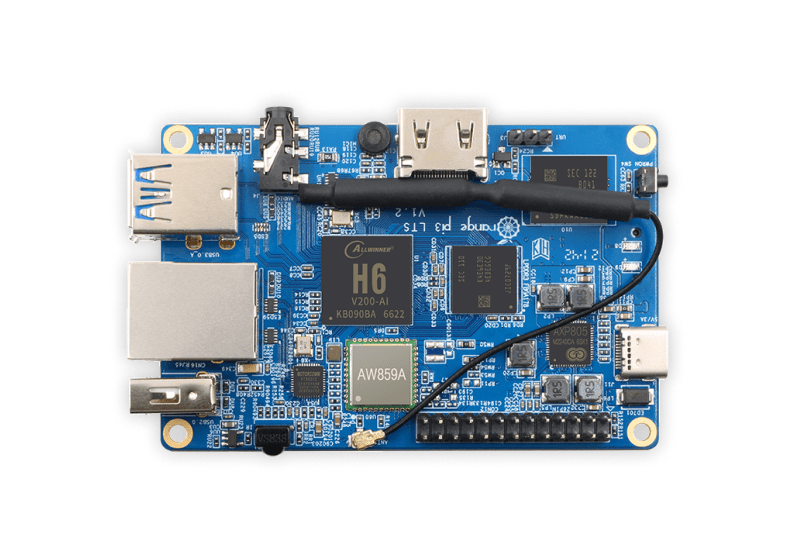Table of Contents
Maybe you missed it? NanoPi R4S Review
Orange Pi 3 LTS
Orange Pi 3 LTS is an open-source single-board computer, a new generation of ARM development board designed by Shenzhen Xunlong Software CO., LTD, The company behind the successful Orange Pi brand. This new model is a new successor to the previous Orange Pi 3 series launched back in 2019 but with a few major improvements worth talking about.
Hardware and Interfaces
Under the hood, the new Orange Pi 3 LTS SBC (single board computer) features a brand new Allwinner H6 quad-core Cortex-A53 processor, Gigabit Ethernet, four USB 3.0 ports, AW859A WiFi & Bluetooth chip which replaces the Ampak AP6256 module from the original board. Also, the mPCle socket has also been removed in favor of additional space for the eMMC and 8GB RAM chips.

Orange Pi 3 LTS PC dimensions have also been reduced to a smaller size form factor, measuring only 56x85mm. Xunlong company added 2GB LPDDR3 RAM and a pair of USB V3.0 hosts along with one single USB V2.0 host port. A new USB Type-C has also been changed to the Micro-USB power input of the previous model. As for other interfaces, you can find a power button, a typical 26 Pin GPIO pin header, HDMI 2.0 port, Debug TTL UART, IR Receiver, onboard microphone, and an audio / AV output.
Software Support
In the software arena, the Orange Pi 3 LTS runs Android 9.0 OS, Ubuntu, Debian, and most likely Armbian Linux distribution will be also supported in the near future.
Orange Pi 3 LTS | Front view

Orange Pi 3 LTS | Back view

Orange Pi 3 LTS specifications
- SoC – Allwinner H6 quad-core Cortex A53 processor clocked at up to 1.8 GHz Arm Mali-T720MP2 GPU supports OpenGL ES 3.1/3.0/2.0/1.1, DirectX 11
- System Memory – 2GB LPDDR3
- Storage – 8GB eMMC flash, MicroSD card slot.
- Video & Audio Output – HDMI 2.0a up to 4Kp60, 3.5mm AV jack with composite video and stereo audio
- Audio Input – Built-in microphone
- Video Decoding – 10-bit H.265 up to 4Kp60, 6Kp30, VP9 and H.264 up to 4Kp30, AVS+/AVS up to 1080p60
- Gigabit Ethernet via YT8531C chip.
- 802.11b/g/n/ac WIFI 5, and Bluetooth 5.0 via an Allwinner AW859A module
- USB – 1x USB 3.0 port (no more USB 3.0 hub chip), 2x USB 2.0 host ports
- Expansion – 26-pin header with GPIOs, I2C, UART, SPI, 5V, 3.3V, and GND
- Debugging – 3-pin serial console / UART header
- Misc – Power button; IR receiver; power and status LEDs
- Power management chip: AXP805
- Power Supply – 5V/3A via USB-C port
- Dimensions – 85 x 56 mm (was 90 x 64 mm)
Kit (Optional):
- Orange PI3 LTS Board.
- 5V3A US Type-C Power Supply.
- Aluminum Heat Sink.
New vs. Old – Comparing SBCs Dimensions

Price & Availability
Orange Pi 3 LTS single-board computer is currently available for a price of $35 USD on Shenzhen Xunlong Software LTD. Official AliExpress store.

